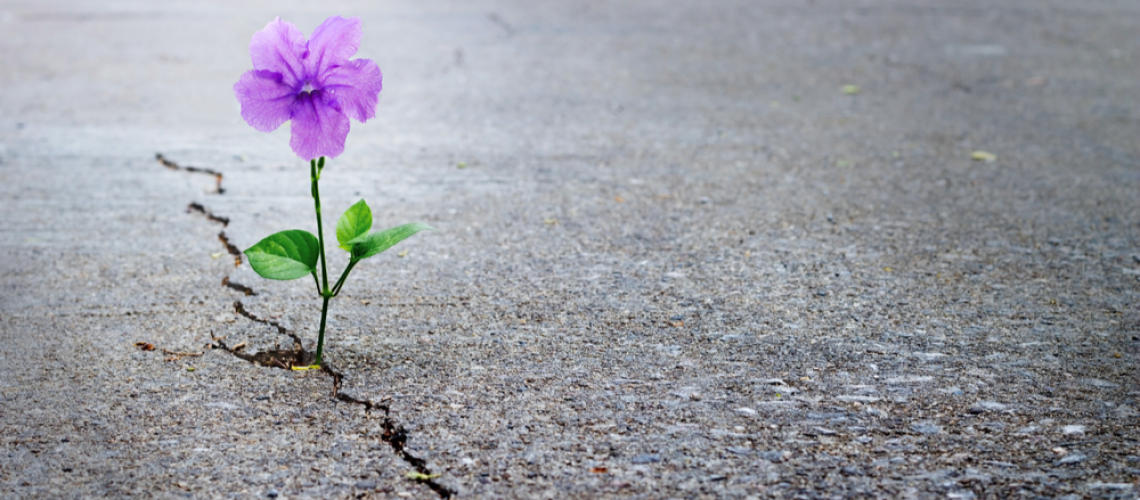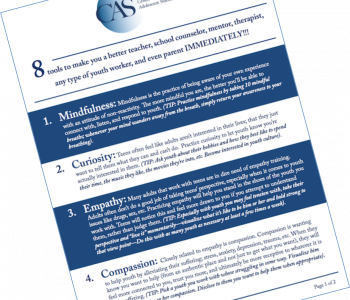

Sam Himelstein, PhD
Sam Himelstein is the founder and CEO of the Center for Adolescent Studies, Inc. He is passionate about working with youth and training the professionals that serve them.
3 Steps to Build Resilience and Practice Self-Care for Helping Professionals in Uncertain Times
This past week life on our planet has been significantly disrupted. Earlier this week the area where I personally live was put on a shelter in place order and toward the end of the week the state Governor had issued a statewide stay at home order to stop the spread of the Novel Coronavirus (COVID-19).
Weddings are being cancelled, birth of children are happening without the comfort and abundance of extended families being present, and funerals are taking place with family members that can be counted on one hand. Workers are being sent home, some with no job. Small businesses are becoming stressed to the point of implosion, and our economy is tanking.
It would be an understatement to write that our planet as a whole is simply stressed out.
And we as helpers; be it therapists, educators, mentors, physicians, nurses, human resources personnel, etc., are still charged to care for others as we ourselves experience this dismay in our own lives.
This is why self-care and resilience are so important. If we want to help, we must tend to ourselves both individually and collectively. I was inspired to write this post given my gratitude for what’s been cultivated in the last few years at the Center for Adolescent Studies. Although it’s still in its infancy as an organization, we have over 20,000 individuals from youth-serving organizations who receive our emails and over 30,000 on social media. So I wanted to write this short post as a way to promote self-care and resilience during these uncertain times. It isn’t exhaustive, but rather an invitation to plant your own seeds of self-care so that you and those around you can build resilience during these difficult times.
What is Resilience? What is Self-Care?
Simply put, resilience is our ability to overcome difficulty. If our difficulty is too extreme to overcome, our central nervous system has the capacity to send us into the fight, flight, freeze, and feigned death responses. Often when that happens a sense of fear and lack of safety arise and there is a stronger potential to become traumatized.
The way to mitigate that stress response is to make it manageable. That’s where self-care strategies come into play. Self-care is the set of strategies that we rely on to overcome difficult experiences.
Self-care is oftentimes thought of as a reactive: “x happened, so now I’m going to do y,” which is not untrue, but if we want to develop resilience the key is to have a strong self-care routine that’s practiced proactively. Self-care strategies are one way of mitigating our stress response in these uncertain times of the COVID-19 pandemic.
One Layer Deeper: 3 Types of Self-Care
Disclaimer: I don’t intend for this post to be exhaustive (I want to keep it short) but it does reflect a good amount of my current thinking about self-care. What’s omitted from this post are my thoughts on collective self-care and the negative role neoliberalism can sometimes have on the responsibility of individual self-care. I’ll save that for another post.
Generally, I tend to think of self-care strategies within three major categories:
- Regular Relaxation Response: This is the calming the central nervous system so that our parasympathetic “relaxation response” is activated. This is our “rest and digest” system and is necessary on some level to feel physically and emotionally safe. These strategies can include light exercise that produce endorphins, short meditations and relaxation-based training (e.g., deep breathing), music, hiking and nature, massage, and so on. What’s important for this strategy is that the relaxation response is regularly cultivated. More on routines below.
- Effortful Training: Paradoxically, this is on the other side of the spectrum than the regular cultivation of the relaxation response. This is where we stress our system to a degree, but with a payout. Exercising, eating healthy, sleep routines, prolonged meditation; these can easily be difficult things to do and may not feel “good” or “calming” in the moment, but they have a positive payout for our minds and bodies. Also within this category (at least interpersonally) is saying “no.” Having boundaries can be an important self-care strategy and when we do so collectively, we are saying “no” to an injustice that often impacts large quantities of providers (e.g., educators, mental health workers going on strike for better working conditions). I guess I couldn’t refrain from writing at least something about collective self-care.
- Creative Expression: This strategy has to do with the flow of your creative juices. These methods inspire innovation, reflection, inspiration, and its namesake, creativity. Writing, art, dance, singing, editing, and so on can foster creativity.
Examples of strategies from each of the above self-care buckets really are in the eye of the beholder. It’s important to choose strategies that work for you and facilitate those respective experiences. It’s also important to be honest about which strategies actually lead to health long term rather than simply being a crutch in the moment. I support a lot of individuals in recovery in my therapy practice that would be quick to tell you that drinking alcohol definitely activates their relaxation response. Hence, not everything that makes you feel relaxed is the best thing for your health long term.
With the above in mind, here are three simple steps to help you build resilience through self-care strategies, especially in uncertain times. Remember, this isn’t exhaustive. This post is meant to help you plant a seed that you can continue to nourish over time.
1) Identify at least 1 strategy from each self-care category from above and put them in your schedule
What helps your nervous system relax? Try to identify at least 1-2 (preferably more) activities that can facilitate calmness. Do the same for the other two categories and then (and this is most important) create a draft schedule where you do at least one thing, however short, per day. The schedule should be achievable and realistic.
Creating the routine is as important as the strategies themselves. The routine creates predictability and over time, self-care strategies that are predictably practiced will result in resilience. More on routines below.
Here are a few of mine for the sake of example:
Regular Relaxation Response:
- Deep, diaphragm-based breathing
- Light hiking in nature (where I live, the redwoods)*
- One on one connection with close friends and family*
- Light stretching
Effortful Training:
- Mindfulness; both through formal mindfulness meditation and informal, daily mindfulness, for the development of equanimity.
- Compassion; both for myself and others
- Exercise; basketball, pickleball, and self calisthenics training*
- Consistent sleep routine
Creative Expression:
- Writing
- Creating new course content for my online courses
- Brainstorming business ideas
- Pretend play with my kids
Anything with an asterisk (*) above means these practices have had to be modified in some way due to the stay at home order. Also please note: I will be facilitating a live webinar where I go much deeper into how to develop inner self-care/resilience strategies such as mindfulness, self-compassion, and others. Please scroll down to the end of this post for more information.
2) Stay apart physically, connected socially
Probably deserving a whole separate bucket for self-care above, is staying connected with people we love and care for. At this point many of us have heard countless calls for “social distancing” as a way to fight the spread of the coronavirus. This of course is extremely important however it isn’t the “social” distancing that’s important. It’s the “physical” distancing that we need to follow (thanks to my friend and colleague Dr. Chris Willard for early social media posting about this concept/practice).
If you are in an area with a stay at home order, don’t forget that you can reach out to your friends, family, and colleagues to check in, share gratitude, compassion, and so on through phone calls and video calls. Set up a free Zoom or Skype account to see and meet with your friends and family live (i.e., stay socially connected)but physically at a distance. Process your feelings, invoke your others on the path of practice self-care, and set-up accountability partners.
As of publishing this post (5 days after the our shelter in place order) I have set up a live video call with my parents so my kids could hang out with their grandparents, have had two different video conferences with two different sets of five friends, and am scheduled for my third tonight.
3) Develop a Home Routine
Another Disclaimer: If you aren’t stuck at home, AKA you’re a healthcare or mental healthcare worker who is under even more stress treating COVID-19 head on or its impact on people, you’re probably working a lot harder than usual. For you, make sure to take step 1 above seriously so that you can get some activation of the relaxation response, refresh, and reset yourself for more work. And thank you for your service.
If you are stuck at home more than expected and feeling cooped up, it’s important to create routine. Just like having an actual routine for self-care, having a general routine throughout the day can help you not get stuck in the dwelling of anxiety, depression, or other strong emotions.
It’s easy to turn on the TV and constantly watch the news, take extra naps (that was me the first two days), and have a hard time cultivating motivation. If you work from home, develop your self-care routine within your overall work schedule and social time.
If you’re a parent and have your kids at home, develop a schedule for both them and you to help facilitate learning/academic times to bring some structure to your day. And no, it doesn’t need to be extreme with kids waking up to do math at 7am. Make it feasible for you.
Again, the role of routines is that they create predictability. In uncertain times this is even more important because our reliance on regular predictability; going to work, kids at school, social activities on the weekends, isn’t being awarded to us. So inner predictability can go a long way . Predictability over time, when practiced healthily (i.e., via your self-care strategies), leads to resilience.
To learn more about self-care and the building of resilience, register for our free online course: “Resilience and Self-Care Basics for Helping Professionals ” below. It’s free!

